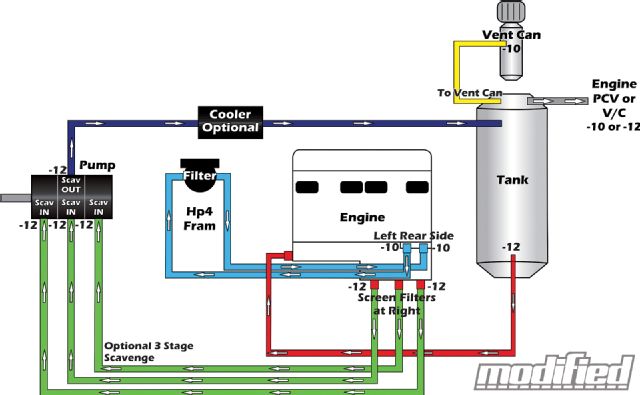Dry-sump oiling systems offer numerous advantages, including improved engine reliability and longevity, the ability to lower the engine for improved handling dynamics while reducing crankcase pressures, and the possibility of an increase in power output.
The improved reliability comes from the remote-mounted oil reservoir, which is designed to be tall and slender, ensuring that no matter how much lateral or longitudinal acceleration is generated, a fresh supply of air-free oil is always being fed to the engine. Constant oil supply means reduced bearing wear and increased engine longevity.
The ability to lower the engine in the bay is a result of the shallow-depth pan design that can be fitted when using a dry-sump system. Because the bulk of the engine oil is no longer being stored in the sump of the oil pan, the pan can be very shallow, allowing our engine to sit 1.25 inches lower.
 | ARE Dry-Sump System - Project honda S2000
| ARE Dry-Sump System - Project honda S2000
 |
| Scavenge stages built into the oil pump evacuate oil from the pan and create a vacuum in the crankcase. This vacuum ensures no more issues with excessive crankcase pressure filling up catch cans when on track. Finally, power gains are often seen as a result of the vacuum generated in the pan causing an improvement in piston ring sealing and reduced friction. Gains of 3 to 5 percent seem to be reasonable.
Scouring the Internet reveals limited options when it comes to dry-sumping an F22C in an S2000. Consequently, when the opportunity arose to work with ARE (Armstrong Race Engineering), a leader in dry-sump engine system development and manufacturing, to develop a dry-sump setup specifically for F20/F22C engines in an S2000 engine bay, we jumped at it. The ARE pan design features two screened -10 scavenge ports and a dedicated turbo/supercharger oil return port. The pan also features bosses to secure the included billet/anodized pump mount, which eases the installation process. The low profile pan bolts up without any modifications required to the block and can be used with the engine in its standard location.
Also included in the kit is an ATI crank damper designed to support the ARE pump drive pulley, ensuring a secure and reliable drive interface for the external pump. Speaking of the external pump, it's also an ARE product-a three-stage dry-sump pump. On the pump, you will find two scavenge inlets that are fed from the pan, a scavenge outlet, which feeds oil to the remote tank, a pressure inlet, which receives oil from the remote tank, and a pressure outlet, which supplies oil to the engine inlet.
The remote tank is also manufactured by ARE and is a lightweight piece of aluminum art. This tank uses extensive internal baffling to remove air from the scavenged oil and ensures a continuous supply of engine oil back to the pump. Finally, ARE also includes its breather tank and remote filter mount setup in the kit.
 |
| When installing the system, removal of the OEM oil pump is required, and we opted to have the original oil feed port blocked off while the engine was being assembled at Gord Bush Performance. Installing the pan is a straightforward affair, requiring only a slight modification of the OEM windage tray to bolt up. The ATI crank pulley is a direct replacement part.
The kit comes with the necessary belt and gearing configuration for the S2000, with belt tension being set by using shims under the pump. Our lowered engine configuration resulted in some clearance issues to the steering rack, requiring machining of one rack mounting ear and the use of a slightly narrower 0.75-inch drivebelt. Fitting the tank is a challenge in anything but a dedicated race car and will require some fabrication to properly secure. We opted to rear mount our tank and breather for the improved rearward weight distribution.
 |
| The limited space under the hood also made it an easy decision. Be forewarned that the extra plumbing required for a rear-mounted tank is time consuming and costly to build. Speaking of plumbing, as with the rest of the build, we've been using XRP fittings along with the company's XR-31 hose, and covered the lines where necessary with a high-temp silicone/fiberglass fire sleeve.
I can't stress how important it is to take your time when building and routing your oil lines. Ensure you follow the manufacturer's instructions when assembling your fittings; I see far too many AN reusable-type fittings at the track that are half tightened, waiting to burst and set the car on fire. I also see far too many lines rubbed through by tires and engine drive pulleys, or whatever the case may be. Ensure your lines are properly secured and routed out of harm's way. A failed -12 oil line can oil down the track in a hurry, endangering you and your competitors.
Installing a dry-sump system like this is a time consuming and costly process. There are many factors to take into consideration, not to mention some good fabrication skills are a must. However, the long list of improvements that a dry-sump system affords makes it an easy choice for race use. Taking a walk through any ALMS, Rolex/Grand AM, or other premium-level race series paddock will reveal that dry-sump oil systems are the only way to go.
 |
| 



